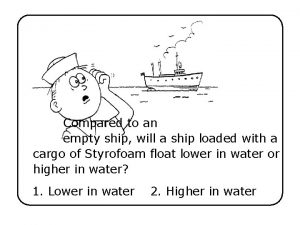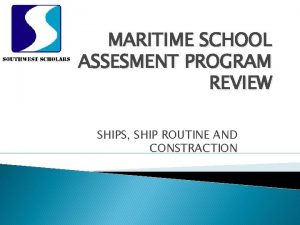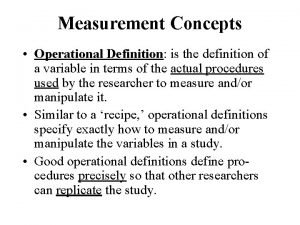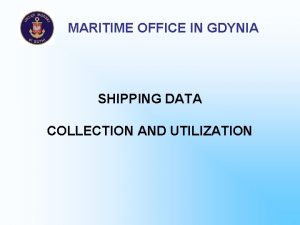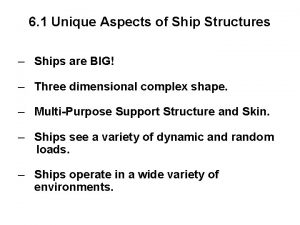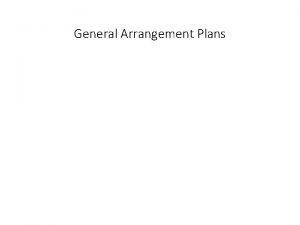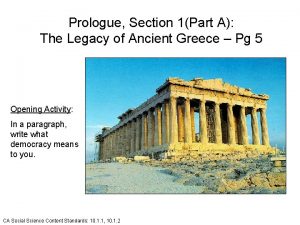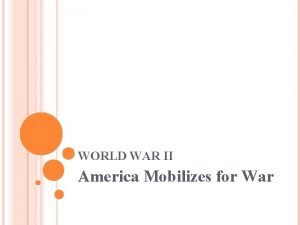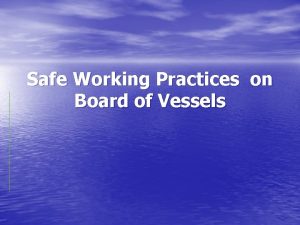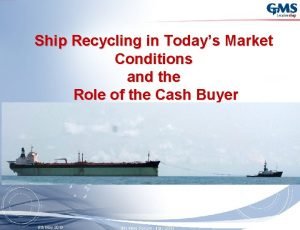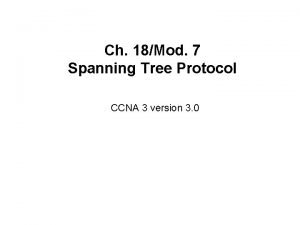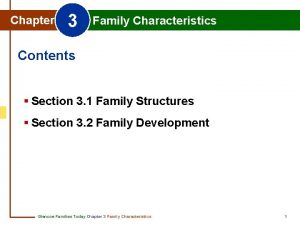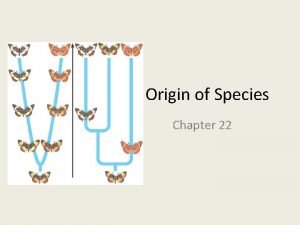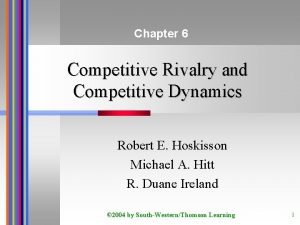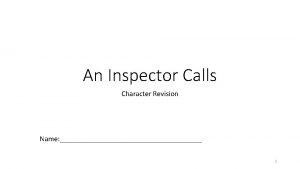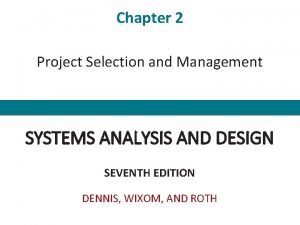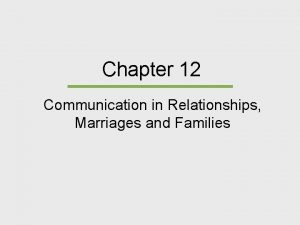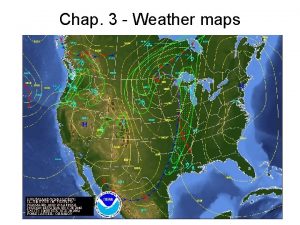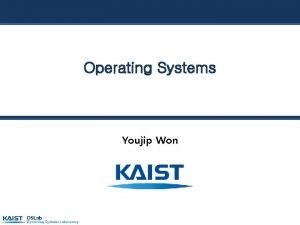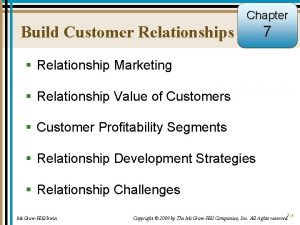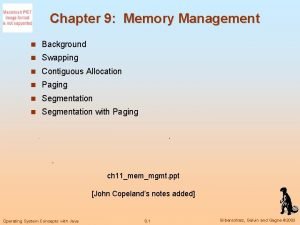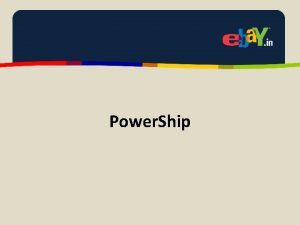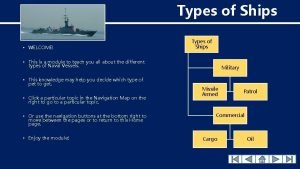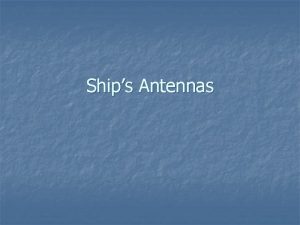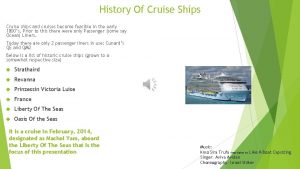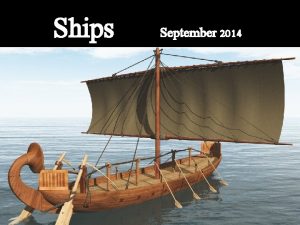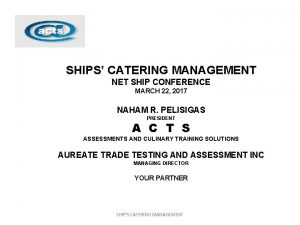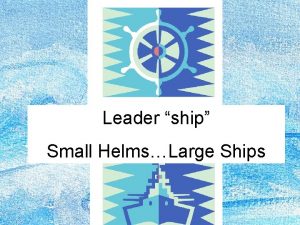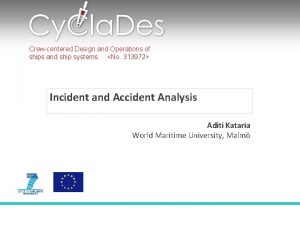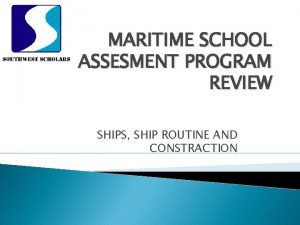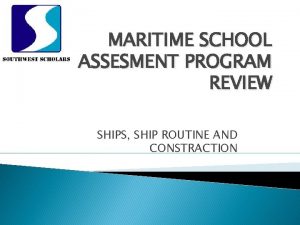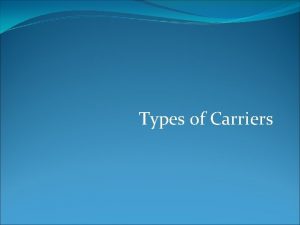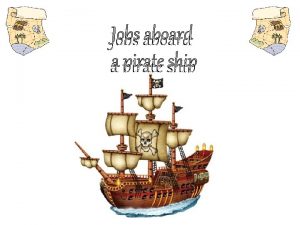Chap 5 Technical Ship Management Ships Their Operational























































- Slides: 55

Chap 5 Technical Ship Management

Ships & Their Operational Problems • Deterioration of ships hull / structure through corrosion, fatigue and damage is identified as a principal factor in the loss of many ships carrying cargo in bulk. • Failing to identify such deterioration may lead to sudden and unexpected accident. Bulk carrier crews may be unaware of the vulnerability of these vessel types. The consequential loss of a ship carrying heavy cargo can be expected to be very rapid, should a major failure occur. : - the process of becoming progressively worse. "a deterioration in the condition of the ship”

Deterioration • The following structural problems are associated with bulk carriers: Ships Corrosion : Ships are built of steel, which in a marine environment exposed to water (both fresh and sea) and air is prone to the formation of rust. Contributing factors that accelerate the rate of corrosion include:

Corrosion

1. Cargo damage : this occurs when heavy bulk cargo is allowed to freefall from height onto the tank tops. The heavy impact of this cargo on the tank top causes damage and breakdown of the coatings on the ceiling of the double bottom tank underneath 2. corrosive cargoes : a number of bulk cargoes contain chemicals of a corrosive nature and this is particularly the case in newly mined coal. It is essential that the data sheet is inspected prior to loading the cargo. For example, in the case of a high sulphur contact coal cargo, severe pitting can result. To counter this, the hold floor can be coated in lime, but this does not protect the bilges or bilge lines

Cargo Damage

3. equipment damage : grab damage to the hold floor, frames and ladders can occur at most discharge ports. This not only causes material damage to the ship's structure, but can also break down the paint coatings exposing the base steel to the atmosphere. The deliberate hammering of the floor and sides of the hold by grabs and bulldozers to free cargo residues trapped between the frames will result in structural damage and the breakdown of the paint coatings 4. seawater corrosion : in the majority of cases, this will take place in the ballast tanks. Many companies now place sacrificial anodes in the ballast tanks, which considerably reduce the corrosive effect of air and saltwater 5. under SOLAS Chapter II-1 double side skin spaces must be provided with a compliant protection coating.

Cargo hold construction of a typical bulk carrier


Metal fatigue • The weakening of the steel in a structure due to constant flexing, under the repeated cycles of stress may result in structural fatigue failure. • The concern about fatigue failure is that it occurs without any apparent forewarning (eg deformation of a structure that results in a crack). • Fatigue usually begins at welded joint notches, discontinuities in structures and areas of high rigidity in particular.

Metal Fatigue • However, variations in the size, shape and design of each component and the conditions that the ship operates mean this may not necessarily result in a structural failure. • Areas where extra vigilant inspection is recommended include: The brackets at the connection of frames to the upper and lower wing tanks the upper and lower connection of corrugated transverse bulkheads corners of the hatch coamings where they are joined to the main deck.

* Bulk carriers in particular become progressively weaker due to continuous corrosion. In addition, the repetitive cycles of changing loads and the resulting stresses due to hogging, sagging, panting, pounding and vibration all increase fatigue. High tensile steel (which is stronger than mild steel) is used in all areas likely to experience high levels of stress. It means that scantlings can be reduced but the vessel will still have higher strength and resistance to stresses, eg slamming due to heavy pitching that may cause fatigue on the forward section of the hull. http: //www. bulkcarrierguide. com/structural-problems. html

Sagging & Hogging

What is Ship scantling. In shipbuilding, the scantling refers to the collective dimensions of the various parts, particularly the framing and structural supports. The word is most often used in the plural to describe how much structural strength in the form of girders, I-beams, etc. is in a given section. The scantling length refers to the structural length of a ship. In shipping, a "full scantling vessel" is understood to be a geared ship, that can reach all parts of its own cargo spaces with its own gear.

Scantling Structures

• It is recommended that, as soon as any cracks are seen, arrangements are made immediately to repair them. • Where possible, a crack arrestor hole should be drilled at each end of the crack before any temporary repair is made. If the extent of the crack is not evident, a detector dye can be used to establish this. • As soon as possible, Class should be called for a survey to make a permanent repair because a crack that is overlooked may become a central point for localised stress resulting in structural failure.

Cracks • * A crack may also damage protective coatings such as paintwork, creating an `open' area for corrosion. • While cracks may not initially be apparent, corrosion in any area should be carefully checked for signs of minor cracks, particularly if there are dents in the structure.

Cracks

Operational Factors * Corrosion and fatigue will gradually weaken the hull over time. This can be increased by variations in loading patterns and particularly heavy density cargoes such as iron ore. * Another factor that gradually weakens a ship's structure is the abrasive and corrosive nature of bulk cargoes such as coal, which can cause unintentional damage to cargo hold coatings. Areas such as welded frame joints with tanktop or deck plating are very likely to develop corrosion and subsequently crack if the coatings are damaged. Other factors include: * Liquefaction of cargoes, caused by water ingress or moisture in the cargo, can cause cargo shift during the voyage * movement of ballast water in partly filled ballast water tanks or holds can cause damage and create corrosion. To avoid this, tanks and holds should be completely filled.

Metal Fatigue ** is the progressive and localized structural damage that occurs when a material is subjected to cyclic loadings. Cyclic loading is the application of repeated or fluctuating stresses, strains, or stress intensities to locations on structural components. The degradation that may occur at the location is referred to as fatigue degradation.

Classification Society International Association of Classification Societies (IACS) Thirteen largest marine classification societies in the world are the members of the International Association of Classification Societies (IACS).

CS A classification society is a non-governmental organization that establishes and maintains technical standards for the construction and operation of ships and offshore structures.

Regulatory System In summary, the regulatory system involves six principal participants in the regulatory process: 1. The classification societies: the shipping industry’s own system for regulating the technical and operational standard of ships. The classification societies make rules for ship construction and maintenance and issue a classification certificate to reflect compliance. 2. The United Nations, which sets the broad framework of maritime law. 3. The flag states. The primary legal authority governing the activities of merchant ships is the state in which the ship is registered, the flag state. By custom this state is responsible for regulating all aspects of the commercial and operational performance of the ship. International laws are developed by the participation of flag states in treaties or conventions.

4. The coastal states. A ship is also subject to the laws of the coastal state in whose waters it is trading. The extent of each state’s territorial waters and the scope of regulation vary from one country to another. 5. The IMO, the UN agency responsible for safety, the environment and security. 6. The ILO, responsible for regulations governing people on board ship.

THE CLASSIFICATION SOCIETIES 1. The shipping industry’s own regulatory system arose from the efforts of insurers to establish that the vessels for which they were writing insurance were sound. 2. In the mid eighteenth century they formed the first classification society and during the intervening period their activities have become so closely involved with the regulatory activities of governments that it is often difficult for laymen to understand the difference between the two. 3. Timely that we focus on the role of classification societies and explain *why they were set up, **how they have evolved, ***the functions they undertake today and their impact on maritime regulation.

Origin of the classification societies * Like many other shipping institutions, the classification societies are the product of their past, so knowing something of their history helps to explain the current structure. • Lloyd’s Register of Shipping, the first classification society, can trace its origins back to Lloyd’s Coffee House in the early 1700 s. The proprietor, Edward Lloyd, presumably in an effort to attract clients, started to circulate lists giving details of vessels which might appear for insurance. • The next step came in 1764 when a committee of London insurers and insurance brokers compiled a book containing details of ships that might require insurance. *

When published the book was known as Lloyd’s Register. This register classified ships according to their quality, listing a grade ‘conferred on the ship by the Committee’s appointed surveyors’. * The condition of the hull was classified A, E, I, O or U, according to the excellence of its construction and its adjudged continuing soundness (or otherwise). * Equipment was graded G, M or B – good, middling or bad. Any ship classified AG was thus as sound as it could be, whilst one rated UB was obviously a bad risk from the underwriter’s point of view. * In time, G, M and B were replaced by 1, 2 or 3.

* The ‘green book’, as it was known, was compiled by insurers for the sole use of members of the society and contained details of 15, 000 ships. • All went well until the 1797– 8 register introduced a new grading system based on where the ship was build, favouring ships built on the Thames. This was disputed by many shipowners, and in 1799 a rival register was published, the New Register Book of Shipping, known as the ‘red book’. • A period of punitive competition followed, bringing both registers close to bankruptcy. In 1834 the differences were settled and a new society was set up to produce a shipping register which was acceptable to all sections of the industry. * The new publication was Lloyd’s Register of British & Foreign Shipping and its governing body had 24 members, eight each from the merchants, the shipowners, and the underwriters. This made it representative of the shipping industry as a whole.

The new society had 63 surveyors and a system of regular inspection for ships was instituted. The main function continued to be the production of a register grading ships, but a new classification system was introduced. • Under this system, *ships that had not passed a prescribed age and had been kept in the highest state of repair were classed A; **ships which, though not fit for carrying dry cargo, were considered perfectly safe for carrying cargoes not damaged by the sea were classed E; ***ships unsuitable for dry cargo, but fit for short voyages (not out of Europe) were classed I. • The condition of the anchor cables and stores when *satisfactory was indicated by 1 and **when unsatisfactory by 2. This system gave rise to the familiar expression ‘A 1 condition’. In the first five years 15, 000 vessels were surveyed and ‘classed’. *

* As the class movement developed in the 19 th century, the role of classification societies changed. At first *the main job was to grade ships. As time passed **they started to set the standards to which ships should be built and maintained. * Blake comments: As its authority grew, the Committee took upon itself something like disciplinary powers. Any new vessel for which an A 1 classification was sought must undergo a survey under construction, which meant in effect that its progress was closely inspected at least three times while the hull was still on the stocks. * A 1 became a requirement rather than a grade in a scale. Technical committees were set up to write rule books setting the precise standards to which merchant ships should be built and maintained. These rules set the standards and the society policed them through their network of ship surveyors.

* Other classification societies were set up in the nineteenth century. The American Bureau of Shipping (ABS) has its origins in the American Ship Masters Association which was organized in 1860 and incorporated in 1862 through an Act of Legislature of the State of New York. • Like Lloyd’s Register of Shipping it is a non-profit making organization with general management vested in the membership comprising individuals prominent in the marine and offshore industries and related fields. Most class societies today are managed by a Board drawn from all parts of the maritime industry – shipbuilders, shipowners, insurers, etc. • * Although underwriters still participate in general management through membership of these boards, the classification societies can no longer be seen as acting exclusively for the insurers.

Classification Society today * There are currently more than 50 classification societies operating world-wide, some large and prominent, others small and obscure. The list of the ten larger societies and the number of cargo ships they class, shown in Table 16. 1 - pg 660, gives a rough idea of the relative prominence of the various institutions. * These are all well-known names in shipping circles and together they cover 90% of the cargo and passenger fleet (note that these numbers do not include the many small non-cargocarrying vessels which the societies also class). * ** Today the main job of the classification societies is to ‘enhance the safety of life and property at sea by securing high technical standards of design, manufacture, construction and maintenance of mercantile and non-mercantile shipping’. The classification certificate remains the mainstay of their authority.

A shipowner must class his vessel to obtain insurance, and in some instances a government may require a ship to be classed. * However, the significance of the classification certificate extends beyond insurance. It is the industry standard for establishing that a vessel is properly constructed and in good condition. * In addition to their role as regulators, the major classification societies also represent the largest single concentration of technical expertise available to the shipping industry. Eg. , Lloyd’s Register, the largest classification society, has over 5, 400 people, of whom half are qualified engineers, operating from 240 offices in 80 countries world-wide. *


Class E-mail ABS abs-worldhq@eagle. org http: //www. eagle. org BV CCS Website (for more specific details) veristarinfo@bureauverit http: //www. veristar. com as. com http: //www. ccs. org. cn/cc ccs@ccs. org. cn swzen/ CRS iacs@crs. hr http: //www. crs. hr DNV iacs@dnv. com http: //www. dnv. com GL iacs@gl-group. com http: //www. glgroup. com IRS ho@irclass. org http: //www. irclass. org KR krsiacs@krs. co. kr http: //www. krs. co. kr LR Lloydsreg@lr. org http: //www. lr. org NK xad@classnk. or. jp http: //www. classnk. or. jp PRS iacs@prs. pl http: //www. prs. pl RINA info@rina. org http: //www. rina. org RS international. dept@rsclass. org http: //www. rs-class. org/


* They class ships against their own rules (around 6600 ships annually), carry out statutory certification against international conventions, codes and protocols, and offer a range of quality assurance, engineering and consultancy services. * In 2007, ABS and its affiliated companies had a global staff of more than 3, 000 people, primarily surveyors, engineers and professionals in the areas of risk assessment and mitigation. * ABS maintains offices or is represented in more than 80 countries. To put this into perspective, the IMO has a permanent staff of about 300 and many important bulk shipping companies have fewer than 100 shore-based staff. • In these circumstances it is easy to see why, in addition to the classification role, the class societies have a major role as technical advisers to shipowners and undertake technical inspection work on behalf of governments.

• Since government regulations cover much of the same ground as classification rules, this sometimes leads to confusion over the role of the classification societies and government regulators. * Although the major societies do not distribute profits, they depend on selling their services to cover their costs and are subject to commercial pressures. As self-funding organizations, their survival depends on maintaining a sufficiently large fee-paying membership to recover their costs. * There is, therefore, intense competition between classification societies to attract members, leaving them in the tricky position of competing for the business of shipowners on whom they will often have to impose financial penalties as a result of their regulatory inspections.

The regulatory activities of the classification societies * The role of the class societies today has two fundamental aspects, (i) developing rules and (ii) implementing them. • !st stage Developing rules includes both new initiatives and the continuous updating of existing rules to reflect changes in marine technology and conventions. • Procedures vary, but most societies develop their rules through a committee structure, involving experts from various scientific disciplines and technical activities including naval architects, marine engineers, underwriters, owners, builders, operators, materials manufacturers, machinery fabricators and individuals in other related fields. • This process takes into account the activities of IMO and IACS unified requirements.

The second stage involves applying the rules to practical shipbuilding and shipping activities. This is a four-step procedure: 1. Technical plan review. The plans of new ships are submitted to the classification society for inspection to ensure that the structural details in the design conform to the society’s rules. If the plans are found satisfactory they are passed and construction can proceed. Sometimes modifications are required, or explanations required on certain points. Alternatively, the society may be asked by the shipyard to help out in developing the design. 2. Surveys during construction to verify that the approved plans are implemented, good workmanship practices are employed and rules are followed. This includes the testing of materials and major components such as engines, forgings and boilers.

3. Classification certificate. On satisfactory completion of the vessel the class is assigned and a certificate of classification is issued. 4. Periodic surveys for the maintenance of class. Merchant ships are required to undergo a scheme of surveys while in service to verify their acceptability for classification. * The ship’s classification society carries out these inspections and keeps records which, for example, a prospective buyer of the ship may ask to inspect.

The classification procedures for existing ships are, in general terms, agreed by IACS for its members and associates. • The regulations typically require a hull and machinery annual survey, a hull and machinery special survey every 5 years, a dry-docking survey every 21⁄2 years, a tail shaft inspection every five years, and a boiler survey every 21⁄2 years. • The hull and machinery survey is very demanding, involving detailed inspection and measurement of the hull. * As the ship grows older, the scope of this inspection widens to cover those areas of the ship which are known to be most vulnerable to ageing. For example, as oil tankers grow older the area of the deck plates subject to tests for corrosion increases.

* To avoid the lengthy time out of service, the classification societies allow owners to opt for a continuous survey consisting of a programme of rolling inspections covering one-fifth of the ship each year. * As more governments have become involved in flag state regulation over the last 30 years, the activities of classification societies as government representatives has increased. * The most common authorizations are in connection with tonnage measurement and load lines, SOLAS, MARPOL and IMO set standards on the transportation of dangerous goods. * In carrying out statutory work, the classification society applies the standards relevant to the country of registry.

The International Association of Classification Societies (IACS) + Over the last 30 years classification societies have been under pressure from shipowners and regulators to standardize their rules. + Non-standard rules mean design work classed by one society may not be acceptable to another, causing unnecessary cost and inconvenience. + For regulators legislating on the technical standards of ship construction, particularly through the IMO, the lack of a common standard complicates their job. + To address this problem, in 1968 the International Association of Classification Societies was set up. Its ten members are listed in Table 16. 1 and account for about 90% of world classification activity.

+ The IACS has two main aims: (i) to introduce uniformity into the rules developed by class societies and (ii) to act as the interface between class societies. A related function is to collaborate with outside organizations and in particular IMO. In 1969 IMO granted IACS ‘consultative status’. + The fact that it is the only non-governmental organization with observer status at the IMO neatly illustrates the position of the classification societies as intermediaries between the commercial shipping industry and governments.

Over the last 30 years IACS has developed more than 160 sets of unified requirements. + These relate to many factors, of which a few are minimum longitudinal strength, loading guidance information, and the use of steel grades for various hull members. + However, a significant step forward came in December 2005 when the IACS Council adopted* + Common Structural Rules for tankers and bulk carriers. For the first time this integrated the rule-making activities of the societies into a single design standard. + The Common Structural Rules were implemented on 1 April 2006.

THE LAW OF THE SEA Why the law of the sea matters * Since maritime law is made and enforced by nation states, the next task is to examine the legal framework which determines the rights and responsibilities of nations for their ocean-going merchant ships. There are two obvious questions. • First, which nation’s law applies to a ship? • Second, what legal rights do other nations have over that ship as it moves about the world? * The answers were not developed overnight, they were evolved over the centuries as a set of customary rules known as the law of the sea.

A Global Trend 1. Lloyd's Register of British and Foreign Shipping‘ was reconstituted as a self-standing 'classification society' in 1834 2. Bureau Veritas (BV) in Antwerp in 1828 3. Registro Italiano Navale (RINA) dates from 1861 4. American Bureau of Shipping (ABS) established in 1862 5. Det Norske Veritas (DNV) in 1864 Germanischer Lloyd (GL) was formed in 1867 6. Nippon Kaiji Kyokai (Class. NK) in 1899 7. Russian Maritime Register of Shipping (RS) 1913 8. Yugoslav Register of Shipping (now Croatia’s CRS) in 1949 9. China Classification Society (CCS), 1956 10. Korean Register (KR), 1960 11. Indian Register of Shipping (IRS), 1975

Role of CS - Key Points * Promotion of safety of life, property and the environment. * Develop technical standards (rules) for design and construction of ships. * Approve designs against their standards. * Conduct surveys during construction to satisfy the ship is built in accordance with the approved design and to the requirements of the Rules. * Acts as a Recognised Organisation carrying out statutory surveys & certification as delegated by maritime administrations. * Regulations for in-service inspection and periodic survey during operation. * Research and development programmes. **Support international organisations – IMO, ISO, IACS. http: //www. wd. gc. ca/eng/13791. asp

Applied to all stages throughout the life of a ship ** Feasibility stage : appropriate rule set or assessment method selected. ** Design stage: ship and its component parts are assessed against the requirements of the nominated standard in a process referred to as design appraisal. ** Construction: survey to ensure that the original design assumptions are met and that the relevant manufacturing standards are complied with. ** In-service: survey to ensure changes to the component do not compromise the requirements of classification. Changes result from modification, repair, degradation

Overview of the Process


What is a Statute? The body of law consisting of written laws adopted by a legislative body. Statute law is often contrasted with case law, which originates from decisions of the appellate courts; and with constitutional law, based on a country's written constitution. * Statutory * required, permitted, or enacted by statute. "statutory controls over prices" * having come to be required or expected through being done or made regularly. "the statutory Hari Raya phone call to his mother"

Statutory

Benefits Classification is a system for controlling or regulating the materiel state of the ship. * Rules for design / construction are extensive and under continual development. * Procedures for manufacture, testing and certification of materials are well established. * Survey and reporting procedures from construction to disposal are well established. * Surveyors are well trained and experienced. * Provides access to a significant depth of knowledge and experience (250 years).
 Chap chap slide
Chap chap slide A boat full of scrap iron floats
A boat full of scrap iron floats Flounder plate ship
Flounder plate ship Economic feasibility in system analysis and design
Economic feasibility in system analysis and design Technical and operational definitions
Technical and operational definitions On a ship, its corresponds to a floor in a building *
On a ship, its corresponds to a floor in a building * Break break break break break
Break break break break break Swibż
Swibż Deck of cruise ship
Deck of cruise ship General arrangement plan ship
General arrangement plan ship Gyroscopic couple definition
Gyroscopic couple definition Xerxes bridge of ships
Xerxes bridge of ships Endoplasmic reticulum factory part or worker
Endoplasmic reticulum factory part or worker How many liberty ships were built
How many liberty ships were built Safe working practices on board ships
Safe working practices on board ships Death ships
Death ships Tudor exploration
Tudor exploration Cash buyer of ships for recycling
Cash buyer of ships for recycling What is the smallest living unit
What is the smallest living unit What organelle ships proteins to the golgi apparatus
What organelle ships proteins to the golgi apparatus 1 of 1 clothing meaning
1 of 1 clothing meaning Passion chap 6
Passion chap 6 Bank run chap 11
Bank run chap 11 Assumptions of clrm gujarati
Assumptions of clrm gujarati I look like a nail but i am a bud
I look like a nail but i am a bud Kstn chap 18
Kstn chap 18 Family control ch3
Family control ch3 Manhwa the origin of species chapter 1
Manhwa the origin of species chapter 1 Satisfying needs parte 3
Satisfying needs parte 3 Origin of species manga chapter 22
Origin of species manga chapter 22 Mad dog ch 25
Mad dog ch 25 Mattew chapter 5
Mattew chapter 5 Chapter 1 learning about children
Chapter 1 learning about children Rivalry chapter 6
Rivalry chapter 6 System engineer chap 1
System engineer chap 1 Chap tree
Chap tree Tree switch
Tree switch I was in that state when a chap easily turns nasty analysis
I was in that state when a chap easily turns nasty analysis The origin of species chapter 24 bl
The origin of species chapter 24 bl Passion chap 9
Passion chap 9 Hình cắt kết hợp
Hình cắt kết hợp In the summer chap 22
In the summer chap 22 Selection project chap
Selection project chap The origin of species ch 18
The origin of species ch 18 Define the relationship chap 12
Define the relationship chap 12 Fitness - chapter 1
Fitness - chapter 1 Chap tree
Chap tree Surface weather station model
Surface weather station model Chap 23
Chap 23 Payback chap 12
Payback chap 12 Chapter 1 why personal fitness
Chapter 1 why personal fitness Youjip
Youjip In the time of the butterflies chapter 10 quotes
In the time of the butterflies chapter 10 quotes 4 tier customer pyramid
4 tier customer pyramid Payback ch 9
Payback ch 9 Schematic view of swapping
Schematic view of swapping

